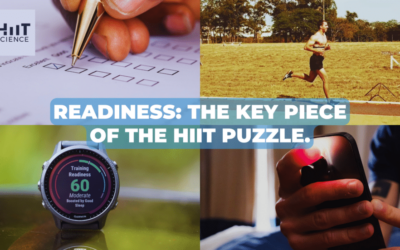I think that we can all appreciate the importance of keeping our players fit and healthy. One means of achieving this in our athletes is through the maintenance of a stable and constant training stimulus. As most of us now realize, when we see large spikes in training load, and especially the high-speed running (HSR) component, we often see injuries (4). A recent expert-led Delphi survey of key football performance practitioners operating in teams across the Big 5 Leagues (Bundesliga, English Premier League, La Liga, Ligue 1, Series A) showed that HSR management was the most effective strategy for preventing lower-limb injuries (5). It is with this particular view of HSR management that I wrote a recent short paper, published in the free, open-access journal, Sport Performance & Science Reports.
For our HIIT Science Blog, I wanted to give a quick overview of the article, where I place special emphasis on the timing and characteristics of high-intensity interval training (HIIT) supplementation for substitute and bench players.
Problem. Figure 1 below shows the in-season HSR distribution measured in a midfielder during both training and matches over a 5-week congested period. As is shown, the player repeatedly performed 600-800m of HSR during the 5 first consecutive matches of that period. Thereafter, however, the coach opted to rest him for the 6th match (26th of September, bench). He then played 30 min as a sub on the 29th, was not selected in the squad for the 2nd of October (cup match for which he wasn’t qualified), played again as a substitute on the 5th of October, remained benched on the 8th (away game), before finally playing another full match on the 12th. If we were to only consider the loading pattern of HSR consecutive to his exclusive participation in training and matches, a spike in load would have been inevitable from the stress associated with the full match on the 12th of October (i.e., Acute/Chronic workload ratio, ACWR >2).

Figure 1. High-speed running distance (>19.8 km/h, HSR) covered during training and matches in a midfielder (22 y-old, playing in a 1st division club) during a 5-week in-season period. The acute (A) and chronic (C) load were calculated over 5 and 20-d periods, respectively. ACWR: A/C workload ratio. A spike (A/C >2) in HSR is shown with the red circle. GPS (training) and semi-automatic (matches) locomotor data were integrated with calibration equations (6). Note that while the match sequence is real, the actual dates have been changed to ensure anonymity.
Remediation strategy. Figure 2 below offers a viable strategy as to how HIIT supplementation (i.e., so-called compensatory training) can permit the maintenance of HSR loading throughout the period where the player did not play much. While no HIIT was programmed on the 26th to enable recovery, compensatory HIIT sessions were implemented subsequently in various contexts during the period of reduced match participation.

Figure 2. High-speed running distance (>19.8 km/h, HSR) covered during training, matches and supplementary high-intensity interval training (HIIT) in a midfielder (22 y-old, playing in a 1st division club) during a 5-week in-season period. The acute (A) and chronic (C) load are calculated over 5 and 20-d periods, respectively. ACWR: A/C workload ratio. GPS (training) and semi-automatic (matches) locomotor data were integrated with calibration equations (6). Note that while the match sequence is real, the actual dates have been changed to ensure anonymity.
This simple addition of four short HIIT sequences, with a volume approximating the match demands (i.e., 600-800m), allowed the maintenance of a stable HSR load, which logically prevented the occurrence of a spike in load on the 12th of October, when the player completed a full match after a period of reduced match participation. This modest, but likely efficient compensation strategy, was either implemented on the fly, immediately after the match when the time and location allowed for it, or the following day at the training ground when the substitute trained.
The SPSR article gives a more detailed example of the HIIT sessions used, both with and without the ball, and suggests how they may be implemented seamlessly alongside the competition schedule. Our HIIT Science book and course provide even greater specifics on the science and application of HIIT for those interested in the topic.
Summary. In substitute or bench players, HIIT supplementation immediately after matches or the following day is a practical and likely efficient strategy for the maintenance of a stable HSR load over the weekly cycle.
If you’re Interested in learning more about HIIT science and application for specific sports, we offer an online HIIT Course.
- Buchheit M. Applying the acute:chronic workload ratio in elite football: worth the effort? Br J Sports Med. 2017;51(18):1325-7.
- Lolli L, Batterham AM, Hawkins R, Kelly DM, Strudwick AJ, Thorpe RT, et al. The acute-to-chronic workload ratio: an inaccurate scaling index for an unnecessary normalisation process? Br J Sports Med. 2018.
- Fanchini M, Rampinini E, Riggio M, Coutts A, Pecci C, McCall A. Despite association, the acute:chronic work load ratio does not predict non-contact injury in elite footballers. Science and Medicine in Football. 2018: In press.
- Duhig S, Shield AJ, Opar D, Gabbett TJ, Ferguson C, Williams M. Effect of high-speed running on hamstring strain injury risk. Br J Sports Med. 2016.
- Fanchini M, Pons E, Impellizzeri F, Dupont G, Buchheit M, McCall A. Exercise-based strategies to prevent muscle injuries. Muscle injury guide: Prevention of and return to Play from muscle injuries. 2019;Chapter 1:34-41.
- Buchheit M, Allen A, Poon TK, Modonutti M, Gregson W, Di Salvo V. Integrating different tracking systems in football: multiple camera semi-automatic system, local position measurement and GPS technologies. J Sports Sci. 2014;32(20)(20):1844-57.
- Buchheit M, Mayer N. Restoring players’ specific fitness and performance capacity in relation to match physical and technical demands. Muscle injury guide: Prevention of and return to Play from muscle injuries. 2019;Chapter 2:29-37.
- Laursen PB, Buchheit M. Science and Application of High-Intensity Interval Training (HIIT): Solutions to the Programming Puzzle: Human Kinetics; First edition (December 28, 2018); 2018. 664 p.
- Lacome M, Simpson BM, Cholley Y, Lambert P, Buchheit M. Small Sided Games in elite soccer: Does one size fits all? Int J Sports Physiol Perform. 2017:Jul 17:1-24. doi: 10.1123/ijspp.2017-0214. [Epub ahead of print].
- Buchheit M. The 30-15 Intermittent Fitness Test: accuracy for individualizing interval training of young intermittent sport players. J Strength Cond Res. 2008;22(2):365-74.
- Buchheit M. Individualizing high-intensity interval training in intermittent sport athletes with the 30-15 Intermittent Fitness Test. NSCA Hot Topic Series wwwnsca-liftorg. 2011;November.
- Gabbett TJ. The training-injury prevention paradox: should athletes be training smarter and harder? Br J Sports Med. 2016;50(5):273-80.







